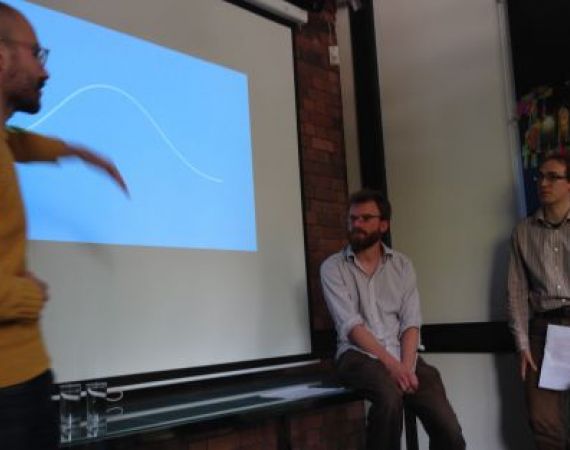Posted on Tue 20 May 2014
UX in IoT Lunchtime Talk Write-up
On 9 May, Studio residents, Tom Metcalfe, Tim Senior and Simon Moreton gave a lunchtime talk about user experience within the Internet of Things. Designer, Neuroscientist and Geographer by training respectively, Tom, Tim and Simon currently all work as part of REACT, a 4 year AHRC funded initiative…

Tom, Simon and Tim
On 9 May, Studio residents, Tom Metcalfe, Tim Senior and Simon Moreton gave a lunchtime talk about user experience within the Internet of Things. Designer, Neuroscientist and Geographer by training respectively, Tom, Tim and Simon currently all work as part of REACT, a 4 year AHRC funded initiative exploring collaborative methods to get creative practitioners and academics working together to make exciting things happen. Objects Sandbox is a REACT scheme, which is currently supporting six projects exploring Connected Objects. They each spoke to us about their different insights into collaboration and UX in IoT. Here is a summary of some of the key things they discussed...
Speaking first, Tim, REACT’s Objects Sandbox Researcher, began the talk with the thought that Connected Objects are moving towards a state of ubiquity, and this is changing the relationship between our notions of individual and social, public and private, and physical and digital. All human activity is shaped through interaction with objects. We don’t just use objects; we live with and through them, and in terms of Connected Objects and Human/Computer Interaction, ‘we cannot not interact’.
As a step beyond the rhetoric of smart-fridges, REACT is looking at how connecting objects to the internet or one another allows them to tell richer stories or take on greater nuance or narrative.
There is a risk that in exploring the role of the arts, humanities and sciences in the shaping of possible IoT futures, the conversation becomes too complicated and unfocused. The challenge is to engage people in this conversation productively, and to create a scenario where the IoT space can be meaningfully contested.
Talking about the Objects Sandbox scheme as a whole, Tim said that ‘practices in IoT will emerge as we make them. This scheme isn’t just about research but actually about doing things in the real world. Theory and making need to feed into one another.’
Simon, REACT Research Fellow, then spoke about the collaborative aspect of the scheme. He said that there are many different ways that people come together to imagine a possible future. There is no tried and tested way to merge arts, humanities, sciences and the commercial/cultural sectors, and REACT exists in a curious space where it is possible to experiment with this sort of collaboration.
Managing and structuring collaboration is not as easy as putting people in a room together. Most of the REACT projects include a very diverse range of collaborators. People come with their own vocabularies. Despite this, in many cases, by the end of a 6 month Sandbox, project participants were finding common language and appropriating one another’s terminology, and seemed equally enthused about each others’ disciplines.
Simon mentioned that another challenge for REACT lies in knowing how to understand, capture and record the real value of this type of collaborative scheme beyond just the financial. This is something they plan to explore further during the course of REACT.
Tom, Objects Sandbox Producer, then spoke a bit about some of the projects involved in the scheme, and where they were in the design process. Among the Objects Sandbox projects are Reflector, a project exploring ways of communicating the stories of historical objects without the objects being there, The God Article, a project which is looking at an ancient Turkish instrument, the Ney, and how to be taught by maestros remotely, and the Breathing Stone, an object which monitors your heart rate and plays music to match your body’s own bpm, reducing anxiety.
To find out about these projects, which are beating a new path for themselves in the unexplored territories of IoT, visit the Objects Sandbox projects page.